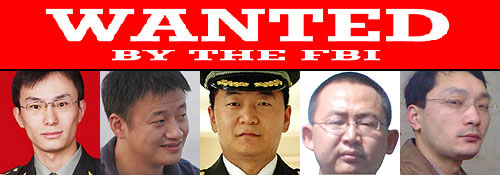Five Chinese military hackers have been indicted on charges of computer hacking, economic espionage and other offenses directed at six American victims in U.S. nuclear power, metals and solar products industries. Charges were filed in the Western District of Pennsylvania, marking the first time criminal charges have been filed against known state actors for hacking.

(From left to right, Chinese military officers Gu Chunhui, Huang Zhenyu, Sun Kailiang, Wang Dong, and Wen Xinyu.)
Defendants Wang Dong, Sun Kailiang, Wen Xinyu, Huang Zhenyu and Gu Chunhui, who were officers in Unit 61398 of the Third Department of the Chinese People’s Liberation Army, were allegedly involved in a hacking conspiracy that targeted Westinghouse Electric Co.; U.S. subsidiaries of SolarWorld AG; United States Steel Corp.; Allegheny Technologies, Inc.; the United Steel, Paper and Forestry, Rubber, Manufacturing, Energy, Allied Industrial and Service Workers International Union; and Alcoa, Inc. The crimes allegedly took place from 2006-2014.
“The range of trade secrets and other sensitive business information stolen in this case is significant and demands an aggressive response,” said Eric Holder, U.S. Attorney General. “Success in the global market place should be based solely on a company’s ability to innovate and compete, not on a sponsor government’s ability to spy and steal business secrets.”
“State actors engaged in cyber espionage for economic advantages are not immune from the law just because they hack under the shadow of their country’s flag,” said John Carlin, assistant attorney general for national security. “Cyber theft is real theft, and we will hold state-sponsored cyber thieves accountable as we would any other transnational criminal organization that steals our goods and breaks our laws.”
As FBI Executive Assistant Director Robert Anderson emphasized, “If you are going to attack Americans—whether for criminal or national security purposes—we are going to hold you accountable, no matter what country you live in.”